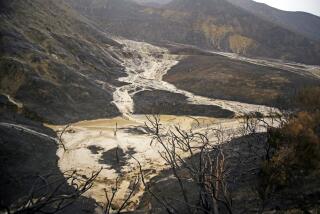Report Warns of Beach Erosion
Sea walls and other artificial barriers built to protect oceanfront property against erosion are self-defeating and represent a major threat to the state’s shoreline, a new environmental report warned Tuesday.
The Surfrider Foundation predicted in its third annual State of the Beach Report that if the use of sea walls, jetties and revetments continues unchecked in California, many popular beaches will eventually be stripped of their sand.
“Armoring the coast does not work,” said Chris Evans, executive director of the Surfrider Foundation, which has 56 chapters across the country. “No question about it, our beaches are disappearing.”
About a quarter of the coastline along a 535-mile stretch from San Francisco to the Mexican border is now fortified against erosion, according to the California Coastal Commission. The agency estimates that about 10 miles of sea walls were added in the last decade.
Almost the entire coast from Dana Point to San Clemente in Orange County is armored, as well as 74% of northern Monterey Bay, 65% of Ventura County’s coastline and 45% in Malibu.
Researchers say the proliferation of jetties, sea walls and boulders placed at the base of oceanfront bluffs is altering the character of the California coast for the worst. The structures can destroy public access and deprive the state’s beaches of their most valuable asset by disrupting the natural forces that move sand along the shoreline.
In the end, critics say, the artificial barriers succumb to the sea’s constant pounding, providing only temporary relief to wealthy property owners at the expense of the rest of the state’s beachgoers.
The problems have prompted some states to ban sea walls, while others have imposed substantial restrictions. In California, such erosion controls remain popular because state law requires their approval if structures are threatened.
Last year, however, the California Resources Agency began considering changes that could limit shoreline armoring. It was the agency’s first proposed revision of statewide coastal erosion policies in 23 years.
“The only long-term solution is some kind of managed retreat from the beach,” said Chad Nelsen, Surfrider’s environmental director and author of the beach report. “There are already places where the beach is gone at high tide.”
The foundation’s yearly report evaluates the health of the nation’s coastline using several factors, including beach access, water quality, erosion and surfing areas. The study involves 20 coastal states where Surfrider has chapters.
“Like the hole in the ozone layer, we know that the California coastline as well as the nation’s coastline are in decline,” Evans said. “The report is an attempt to see how we are doing across time.”
Besides highlighting beach erosion, the foundation gave low marks to California for coastal water quality, noting that state beaches were closed or posted with pollution warnings 6,000 times in 2000, almost double the incidents of the previous year.
Ocean testing in the state has revealed the continual presence of pesticides and herbicides as well as human viruses, fecal coliform and other disease-causing bacteria.
The report stated that from Santa Barbara to the Mexican border alone, there were 19 sewage outfalls that discharge about 1.2 billion gallons of polluted water into the ocean every day.
On a positive note, Surfrider officials praised the California Coastal Conservancy, which has spent more than $200 million since 1976 to protect and restore coastal resources.
More to Read
Sign up for Essential California
The most important California stories and recommendations in your inbox every morning.
You may occasionally receive promotional content from the Los Angeles Times.











